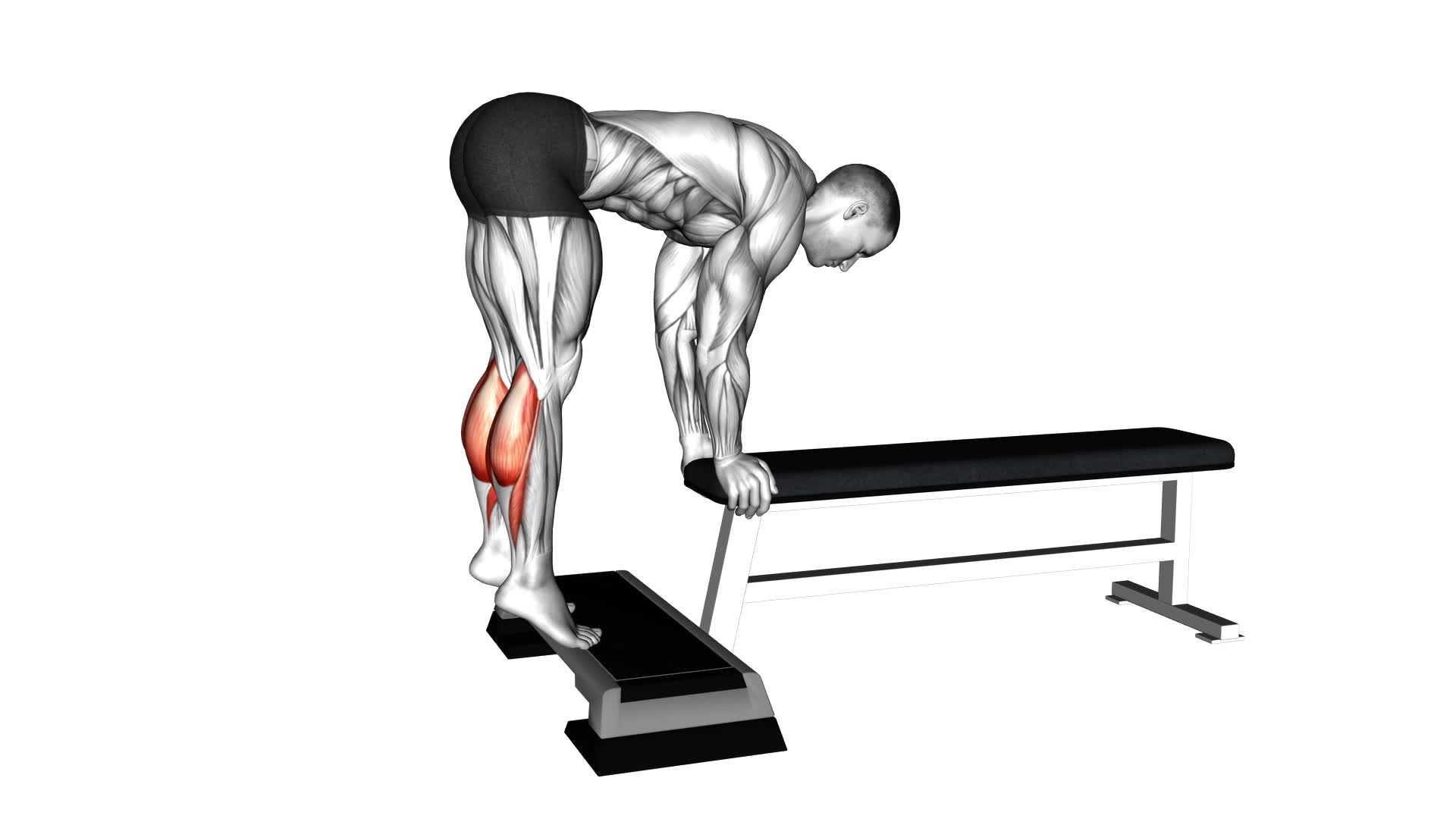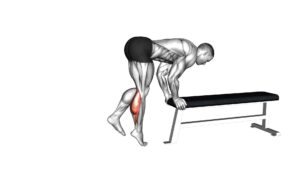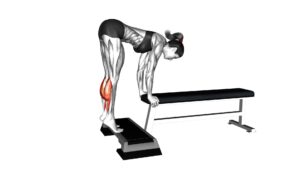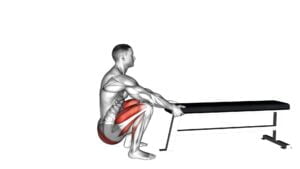Donkey Calf Raise – Video Exercise Guide & Tips

Looking to strengthen your calves? Check out this video exercise guide and tips for the Donkey Calf Raise!
Watch This Exercise Video
This effective exercise targets your calf muscles and can be done with minimal equipment.
Learn the proper form and technique to maximize results and avoid common mistakes.
Whether you're a beginner or advanced, these variations and modifications will help you tailor the exercise to your fitness level.
Get ready to feel the burn and see progress in no time!
Key Takeaways
- Donkey Calf Raise is an effective exercise for increasing calf muscle strength and size.
- Proper form and technique, such as keeping the back straight and engaging core muscles, are crucial for maximizing effectiveness and avoiding injury.
- The exercise can be tailored to different fitness levels by adjusting foot positioning and range of motion.
- Variations and alternatives, such as standing calf raise and seated calf raise, can be incorporated to challenge the calf muscles and add variety to the workout routine.
Benefits of Donkey Calf Raise
You can experience increased calf muscle strength and size with the Donkey Calf Raise. This exercise not only targets your calves but also helps in improving balance and increasing calf strength.
The Donkey Calf Raise primarily focuses on the gastrocnemius, which is the larger muscle in your calf. By performing this exercise, you can effectively strengthen and tone your calves.
To perform the Donkey Calf Raise, you'll need a partner or a calf raise machine. Start by positioning yourself on the machine or having your partner sit on your lower back. Place the balls of your feet on the edge of a raised surface, such as a step or block. Keep your legs straight and lower your heels towards the ground, allowing your calves to stretch.
Then, rise up onto your toes as high as possible, contracting your calf muscles. Hold the contraction for a second before slowly lowering your heels back down.
By incorporating the Donkey Calf Raise into your workout routine, you can enhance your calf strength and size. Additionally, this exercise helps in improving your balance, which is crucial for overall stability and coordination.
Remember to start with lighter weights and gradually increase the resistance as your calf muscles become stronger.
Proper Form and Technique
To ensure proper form and technique during the Donkey Calf Raise, focus on maintaining a straight leg position and gradually lower your heels towards the ground. Here are some best practices to keep in mind:
- Position yourself on the calf raise machine with your shoulders under the pad and your toes on the edge of the platform.
- Keep your back straight and engage your core muscles to maintain stability throughout the exercise.
- As you raise your heels, push through the balls of your feet and contract your calf muscles. Hold the contraction for a second before slowly lowering your heels back down.
By following these best practices, you can maximize the effectiveness of the exercise and minimize the risk of common errors. Some common errors to watch out for include:
- Arching your back: Make sure to keep your back straight and avoid any excessive arching, as this can put strain on your lower back.
- Bouncing: Avoid using momentum or bouncing at the bottom of the movement. This can reduce the effectiveness of the exercise and increase the risk of injury.
- Lifting too heavy: Start with a weight that allows you to maintain proper form and gradually increase the weight as you get stronger.
Equipment Needed for Donkey Calf Raise
To perform the Donkey Calf Raise exercise, you'll need a calf raise machine. This machine is specifically designed to target and strengthen the muscles in your lower legs. It consists of a platform where you can place your toes and a lever or weight stack that provides resistance as you perform the exercise. The calf raise machine allows you to perform the Donkey Calf Raise with proper form and stability, ensuring maximum effectiveness and safety.
If you don't have access to a calf raise machine, there are alternative exercises for lower legs that you can try. One option is the standing calf raise, where you stand on the edge of a step or platform and raise your heels as high as possible. Another alternative is the seated calf raise, where you sit on a chair or bench and lift a weight or place a resistance band on your thighs while raising your heels.
Now that you know the equipment needed for the Donkey Calf Raise exercise, let's move on to the next section where we'll discuss variations and modifications that can help you add variety to your lower leg workout routine.
Variations and Modifications
One way to vary and modify the Donkey Calf Raise exercise is by adjusting the weight or resistance used. By increasing or decreasing the weight, you can challenge your calf muscles in different ways and continue to make progress.
Here are some variations and modifications you can try to take your Donkey Calf Raise to the next level:
- Single-leg Donkey Calf Raise: Instead of using both legs, perform the exercise with just one leg at a time. This will increase the intensity and target each calf individually.
- Weighted Donkey Calf Raise: Hold a dumbbell or a weight plate against your chest while performing the exercise. This added resistance will make your calf muscles work even harder.
- Plyometric Donkey Calf Raise: Incorporate explosive jumps into the exercise by pushing off the platform and extending your ankles quickly. This advanced technique will improve your power and explosiveness.
In addition to these variations, there are alternative exercises you can try to target your calf muscles differently. Examples include standing calf raises, seated calf raises, and calf raises on a leg press machine. Incorporating these alternative exercises and advanced techniques into your workout routine will keep your calf muscles challenged and help you achieve your fitness goals.
Common Mistakes to Avoid
To avoid common mistakes while performing the Donkey Calf Raise exercise, you should focus on maintaining proper form and technique. One common mistake is using too much weight, which can compromise your form and increase the risk of injury. It's important to start with a weight that allows you to perform the exercise with control and without straining.
Another mistake isn't fully extending your ankles at the top of the movement. To maximize the benefit of the exercise, make sure to push through your toes and fully extend your ankles, achieving a peak contraction in your calves.
Additionally, avoid using momentum or bouncing during the exercise. This can take the focus away from your calves and shift it to other muscle groups, decreasing the effectiveness of the exercise.
Finally, maintain a controlled and slow tempo throughout the movement. Rushing through the exercise can lead to poor form and reduce the effectiveness of the exercise.
By paying attention to these common mistakes and focusing on proper technique, you can ensure that you get the most out of your Donkey Calf Raise exercise.
Now, let's move on to some tips for maximizing your results.
Tips for Maximizing Your Results
To maximize your results with the donkey calf raise, it's important to focus on proper form techniques and target the correct muscle groups.
Maintaining a stable posture and engaging your core throughout the exercise will ensure that you're effectively working your calf muscles.
Additionally, make sure to fully extend your ankles and squeeze your calf muscles at the top of the movement for maximum activation.
Proper Form Techniques
To maximize your results while performing the Donkey Calf Raise, it's important that you maintain proper form techniques. Here are some tips to help you achieve the best results:
- Common Mistakes: Avoid leaning too far forward or backward, as this can put strain on your lower back. Keep your torso upright throughout the exercise.
- Muscle Activation: To target your calf muscles effectively, focus on pushing through your toes and lifting your heels as high as possible. This will ensure maximum muscle activation.
- Range of Motion: Aim to fully extend your ankles at the top of the movement and lower your heels as far as possible to get a full stretch in your calves.
Targeting Muscle Groups
To maximize your results with the Donkey Calf Raise, focus on targeting specific muscle groups by adjusting your foot positioning and range of motion.
By adjusting the angle of your feet, you can shift the emphasis from the gastrocnemius (the larger calf muscle) to the soleus (the smaller calf muscle). Placing your feet with your toes pointing outwards will target the inner calf muscles, while pointing your toes inwards will target the outer calf muscles.
Additionally, varying your range of motion can help activate different muscle fibers within the calves. For example, performing partial reps with a smaller range of motion can target the lower portion of the calves, while full range of motion reps will engage the entire calf muscle.
If you're looking for exercise alternatives to the Donkey Calf Raise, you can try exercises like the standing calf raise, seated calf raise, or calf press on a leg press machine.
Frequently Asked Questions
Can the Donkey Calf Raise Exercise Help Improve Ankle Stability and Prevent Ankle Injuries?
Yes, the donkey calf raise exercise can help improve ankle stability and prevent ankle injuries. Ankle stability exercises, like the donkey calf raise, work the muscles in your lower legs, helping to strengthen them and increase stability.
By doing this exercise regularly, you can build up the strength in your ankles, making them less prone to injuries.
Is It Necessary to Use a Donkey Calf Raise Machine for This Exercise, or Can It Be Done With Other Equipment?
You don't necessarily need a donkey calf raise machine to do this exercise. There are alternative ways to perform the donkey calf raise without a machine.
The benefits of doing the donkey calf raise without a machine include improved ankle stability and prevention of ankle injuries. These alternatives can still target and strengthen your calf muscles effectively.
Can the Donkey Calf Raise Exercise Be Performed by Individuals With Lower Back Pain or Injuries?
Yes, the donkey calf raise exercise can be modified for individuals with lower back pain or injuries. By using a sturdy chair or bench, you can perform a seated calf raise instead. This modification reduces the strain on your lower back while still targeting your calf muscles.
The benefits of the donkey calf raise for lower back pain include strengthening the muscles that support your spine and improving overall posture.
How Often Should the Donkey Calf Raise Exercise Be Incorporated Into a Workout Routine for Optimal Results?
For optimal results, it's important to incorporate the Donkey Calf Raise exercise into your workout routine regularly.
The frequency of performing this exercise will depend on your fitness goals and overall training program.
By including variations of the Donkey Calf Raise, such as single-leg or weighted variations, you can add variety and challenge to your workouts.
Remember to listen to your body and adjust the frequency and intensity as needed to prevent overtraining and avoid injury.
Are There Any Alternative Exercises That Can Target the Same Muscles as the Donkey Calf Raise?
If you're looking for alternative exercises that target the same muscles as the donkey calf raise, there are a few options to consider.
One option is the seated calf raise, which focuses on the calf muscles in a similar way.
Another alternative is the standing calf raise, which can be done with dumbbells or a barbell.
Both of these exercises can help strengthen and tone your calf muscles, just like the donkey calf raise.
Conclusion
In conclusion, the donkey calf raise is a highly effective exercise for targeting and strengthening your calf muscles.
By maintaining proper form and technique, using the necessary equipment, and avoiding common mistakes, you can maximize your results.
Incorporating variations and modifications can also add diversity to your workout routine.
Remember to follow these tips to ensure you get the most out of your donkey calf raise workouts.

Author
Years ago, the spark of my life’s passion ignited in my mind the moment I stepped into the local gym for the first time. The inaugural bead of perspiration, the initial endeavor, the very first surge of endorphins, and a sense of pride that washed over me post-workout marked the beginning of my deep-seated interest in strength sports, fitness, and sports nutrition. This very curiosity blossomed rapidly into a profound fascination, propelling me to earn a Master’s degree in Physical Education from the Academy of Physical Education in Krakow, followed by a Sports Manager diploma from the Jagiellonian University. My journey of growth led me to gain more specialized qualifications, such as being a certified personal trainer with a focus on sports dietetics, a lifeguard, and an instructor for wellness and corrective gymnastics. Theoretical knowledge paired seamlessly with practical experience, reinforcing my belief that the transformation of individuals under my guidance was also a reflection of my personal growth. This belief holds true even today. Each day, I strive to push the boundaries and explore new realms. These realms gently elevate me to greater heights. The unique combination of passion for my field and the continuous quest for growth fuels my drive to break new ground.



